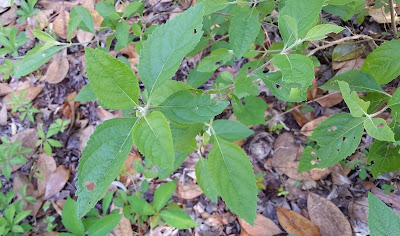Latin Names: x
Type: Herbaceous
Origin: x
Edible: x
Other uses: x
Note: Out back in the field.
 |
| x (June) |
 |
| x (June) |
We have a house on a couple of acres in north Florida. I plan to add posts for every plant I find on our land, identify it, and learn more about it. I am learning as I go so things may change over time. Warning: I am not an expert so research plants on your own before you try any of the "edible" plants.
 |
| x (June) |
 |
| x (June) |
 |
| x (June) |
 |
| x (June) |
 |
| Seedbox (June) |
 |
| Seedbox (June) |
 |
| Seedbox (June) |
 |
| Seedbox (June) |
 |
| Seedbox (June) |
 |
| Seedbox (June) |
 |
| Seedbox (June) |
 |
| Pokeweed (June) |
 |
| Pokeweed (June) |
 |
| x (April) |
 |
| x (June) |
 |
| x (June) |
 |
| x (June) |
 |
| x (June) |
 |
| x (June) |
 |
| x (June) |
 |
| American beautyberry (April) |
 |
| American beautyberry (April) |
 |
| American beautyberry (April) |
 |
| American beautyberry (June) |
 |
| American beautyberry (June) |
 |
| American beautyberry (June) |
 |
| Stemless carline thistle (June) |
 |
| Stemless carline thistle (June) |
 |
| Stemless carline thistle (June) |
Common Names: Bogbutton, bog button,
small’s bog buttons, whitehead
bogbutton, hairy pipewort, hat-pins, bog bachelor’s buttons
Latin Names: Lachnocaulon anceps
Type: Herbaceous
Origin: Native
Description: Small diameter stems for
the flowers grow up to 18” tall. Small leaves at the base of the plant. The flower
is a dense cluster of small white to gray flowers that forms a ball.
Edible: No.
Other uses: None found.
Notes: In the wet field in back.
Blooms June-September.
 |
| Bogbutton (June) |
 |
| Bogbutton (June) |
 |
| Bogbutton (June) |
 |
| Bogbutton (June) |
 |
| Bogbutton (June) |
Common Names: Orange milkwort,
yellow milkwort, bog cheetos, candyweed, red-hot poker, bog bachelor button
Latin Names: Polygala lutea
Type: Herbaceous
Origin: Native
Description: The plant grows up to 12”
tall. The leaves are around 1” long and thick. Flowers are orange and 0.5-1”
long.
Edible: No info found. Perhaps a tea can be made from the leaves. A relative
(polygala nana) has an edible root.
Other uses: Medicinal. Attracts
butterflies.
Notes: In the wet field in back and typically found in wet sandy soil, bogs,
and swamps. Blooms in June-July. Flowers turn yellow when dried. The Latin word
luteus is a saffron-yellow or yellow/orange. Online says this is a biennial so
that I shouldn’t see flowers the 2nd year. Found blooms the 2nd
year but different plants in a slightly different location. However, it also
says this is plant the likes fires it can only grow without competition. We’ve
mowed this area and just now are letting it go natural so it may disappear over
time.
 |
| Orange milkwort (June) |
 |
| Orange milkwort (June) |
 |
| Orange milkwort (June) |
 |
| Orange milkwort (April) |
 |
| Orange milkwort (April) |
 |
| Clubmoss (June) |
 |
| Clubmoss (June) |
 |
| Wild lettuce (April) |
 |
| Rowan (June) |
 |
| Rowan (June) |
 |
| Rowan (June) |